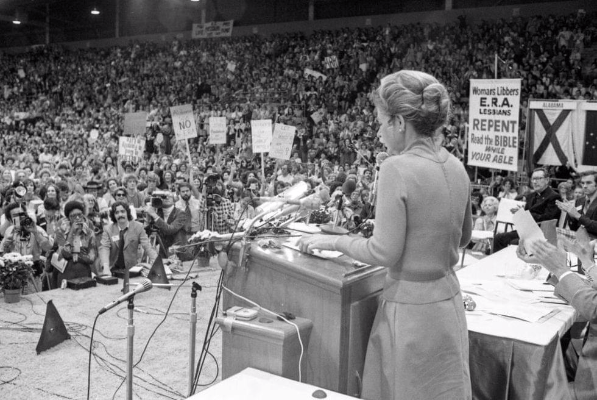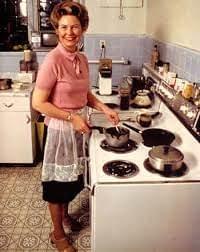By: Kay Slaney
CONTENT WARNING: Misogyny, Homophobia, Racism
Born on August 15th, 1924 in St. Louis Missouri and currently residing in the 9th Circle of Hell, Phyllis Schlafly was an influential conservative activist figure in the ’70s and '80s. She was a key figure in the opposition to the Equal Rights Amendment and the “chairman” of the STOP (Stop Taking Our Privileges) ERA.
Phyllis McAlpin Stewart was the eldest child of John Bruce Stewart and Odile Stewart. Her father was frequently unemployed during the Great Depression, causing her mother to return to work as a teacher and a librarian to keep food on the table (Johnson). Then, the young Phyllis was the valedictorian of the Academy of Sacred Heart High School, a Catholic school and received a scholarship to Washington University where she earned her bachelor degree in 1944 (Johnson). Compared to the average jobs and internships that most college students have to bear, Phyllis Schlafly “worked her way through college on the night shift at the St. Louis Ordnance Plant testing .30 and .50 caliber ammunition by firing rifles and machine guns and as a laboratory technician investigating misfires and photographing tracer bullets in flight.” (Eagle Forum). Talk about a conversation starter!
In 1945, she received her Masters in government from Radcliffe College. She went off to Washington D.C. to work for the conservative think tank American Enterprise Institute and volunteered to serve in Congressional conservative political campaigns. Also In D.C., she met and married her husband, Fred Schlafly Esq. in 1949. 8 years later, the Schlafly’s were primary authors on a paper for the American Bar Association entitled "Report on Communist Tactics, Strategy, and Objectives" (Johnson). The two soon began to rise in prominence and this paper was considered to be a notable driver of anticommunist sentiment during the Cold War Mycarthist era and influential for American Catholics by linking their faith to conservative beliefs and patriotism (Johnson). The Schlaflys then moved to Alton, Illinois and there had six children and was the grandmother of 14.
Image: Phyllis Schlafly (Right) and her family Image Source
Now, to understand the activism and hypocrisy of Phyllis Schlafly, we first need to understand the ERA and its history. The ERA was first introduced in 1923 and was first written by suffragist Alice Paul, where it stalled in the house until the 70s. The reasoning for this amendment to the constitution was that after the passage of the 19th amendment, the suffragists argued that having gender equality in our founding charter would prevent women from being treated as second-class citizens. (Cohen & Codrington). Then in 1972, the ERA managed to pass in the house and stated:
SECTION I. Equality of rights under the law shall not be denied or abridged by the United States or by any State on account of sex.
SECTION II. The Congress shall have the power to enforce, by appropriate legislation, the provisions of this article.
SECTION III. This amendment shall take effect two years after the date of ratification.
Representatives Martha Griffiths (D-MO) and Shirley Chisholm (D-NY) were incredibly persistent in their advocacy for this bill and were influential in making the ERA a top legislative priority (Cohen & Codrington).
Within one year, 30 states ratified the ERA, and 8 more were needed to add the ERA to the constitution. Then Phyllis Schlafly hears about this so-called equal rights and then she is compelled to step into the ring. She founded the STOP ERA organization and named herself “chairman” (Miller, 278). Some of the outcomes that this organization claimed that would arise from the passage of the ERA would be “gender-neutral bathrooms, same-sex marriage, and women in military combat” (Cohen & Codrington) could you imagine the horror! By 1977, thanks to Schlafly, and her slimy band of schophant’s activism, only 35 states ratified the ERA. While a deadline was made for 1982, by that time no other states ratified the amendment so it was virtually dead (Cohen & Codrington).
Image: Map of States that have ratified the ERA. Image Source
To understand how Schlafly’s argumentation influenced so many legislators and citizens, we first need to understand the concept of positive and negative freedom. Negative freedom is when there are no limits to what a person can do. This is a pretty decent idea in concept for someone to have total freedom, but that means that someone can use their freedom to subjugate and oppress someone else because they have the freedom to do so. Positive freedom is where you have the freedom to make your own choices and face the consequences. You have the freedom to do something, not freedom from something.
Schlafly’s main objection to the ERA was that she was defending positive freedom because they believed that patriarchy provided the “natural framework” for women to live in traditional roles. They believed that if the ERA was passed, this would be a form of negative freedom that would cause our very good and white society to crumble the next thing you know, women get equal rights! Could you imagine the horror?
Schlafly argued that women held a “privileged” position in society and that enforcing equality would forfeit the rights and freedoms that women enjoyed (Eric, 285). Women have to bear and raise children, but men are responsible for caring for the woman. According to the devil herself,
“In America, a man’s first significant purchase is a diamond for his bride, and the largest financial investment of his life is a home for her to live in. American husbands work hours of overtime to buy a fur piece or other finery to keep their wives in fashion, and to pay premiums on their life insurance policies to provide for her comfort when she is a widow.”
-Phyllis Schlafly, The Power of the Positive Woman
Schlafly also mentioned that due to a woman’s status in domestic servitude and child-rearing, Women are already offered comfort, safety, and respect, they don’t have to participate in dangerous work or get drafted. She believed that “The women’s libbers (liberators) are radicals who are waging a total assault on the family, on marriage, and on children” (Schlafly, 4)

One common criticism of Schlafly’s activism was that despite her calls to keep women in the home and out of work, Schlafly seemed to have been spending a lot of time out of the house. It is important to note that women don’t need to spend every waking moment in their household, but many people believed that since she was advocating for women to head back to the kitchen, she seemed to be spending very little time baking pies for her husband. While she demanded the “positive women” that followed her to not overpower their husbands, Schalfy often broke that rule. Her ambition for political relevance constantly contradicted her political stances.

Schlafly had a pretty pristine resume where she was giving speeches across the country, was elected as a delegate at the Republican National Convention, and even ran for congress in 1970 (Ribieras, 42). She was also the editor of a monthly newsletter and weekly columnist for The Phyllis Schlafly Report (Eagle Forum). She even wound up with a prominent role in the Reagan administration.
However, despite her hefty contributions to the conservative movement and activism work, Schlafly loved the aesthetics of a homemaker. In 1978, the Schaflys were featured in the Alton Telegraph which downplayed Phyllis’ activism, and the photo for the article, centered on her husband Fred reading a newspaper while Phyllis, well dressed and her hair perfectly done, takes food out of the oven. One reporter even described Schlafly and her goons,
“Looking crisp and composed in a red shirtwaist dress, red-white-and-blue scarf, and frosted hair, Phyllis Schlafly arrived last week at the Illinois capitol with 500 followers. To symbolize their opposition to the Equal Rights Amendment…the women had brought loaves of home-baked bread... as she climbed onto a kitchen stool to address the cheering crowd.”
-Times, 1978

The STOP ERA campaign certainly had a variety of interesting campaigns involving baked goods. In another political stunt, the STOP ERA sent 50 quiches that were sent to senators who supported the ERA. Even the then-senator Joe Biden recieved a shimp quiche (Romano). Apparently, quiche is an emasculating food.
As a counterargument for this alleged hypocrisy, Phyllis Schlafly claimed that "My husband lets me do what I want to do, I have canceled speeches whenever my husband thought that I had been away from home too much…when I fill out applications, I put down 'mother' as my occupation." (Phyllis Schlafly, 1978). Schalfy is also infamous for a statement during a debate with author of The Feminine Mystique and infulential second wave feminist, Betty Freidman in 1973 at Illinois State University. Freidman called Schlafly a “traitor to your sex." To this, Schlafly replied by stating that “I’d like to thank my husband for allowing me to speak here tonight.” (Critchlow, 2005)
Phyllis Schlafly’s influence can still be seen to this day in American conservative politics. The ERA never passed and we now see backsliding legislation that targets women’s bodily autonomy. Without Schlafly and the STOP ERA, we could have equality of the sexes in the Constitution. She must be shedding tears of joy, thinking about our current Supreme Court Justices. Even the aesthetics of Schlafly can be seen in conservative figures such as Sarah Palin and her “mama-grizzly” phrase. Mama Grizzly is in essence, a Karen that goes to school board meetings and beats to the drum of Fox News outrage and pointless culture war buzzwords. Her provactive statements such as, “my husband let me speak tonight" laid the foundations for right-wing provocateurs such as Ann Coulter.
Phyllis Schlafly was certainly an interesting and infamous character in American history.
Works Cited:
Cohen, Alex and Codrington III, Wilfred U. “The Equal Rights Amendment Explained.” Brennan Center for Justice, January 23, 2020 https://www.brennancenter.org/our-work/research-reports/equal-rights-amendment-explained Accessed September 23, 2023
Critchlow, Donald T. Phyllis Schlafly and Grassroots Conservatism: A Woman’s Crusade. Princeton, NJ: Princeton University Press, 2005. Accessed September 23, 2023
Eagle Forum “Phyllis Schlafly: Biography.” Eagle Forum. November 12, 2012 https://web.archive.org/web/20131103171548/http://www.eagleforum.org/about/bio.html Accessed September 23, 2023
Johnson, Arbora. “Phyllis Schlafly.” National Women’s History Museum, 2022. https://www.womenshistory.org/education-resources/biographies/phyllis-schlafly Accessed September 23, 2023
Miller, Eric C. “Phyllis Schlafly’s ‘Positive’ Freedom: Liberty, Liberation, and the Equal Rights Amendment.” Rhetoric and Public Affairs, vol. 18, no. 2, 2015, pp. 277–300. JSTOR https://www.jstor.org/stable/10.14321/rhetpublaffa.18.2.0277
Accessed September 23, 2023
Ribieras, A. (2021). “Stop Taking Our Privileges”: Phyllis Schlafly’s Narrative of Traditional Womanhood and the Fight for Socioeconomic Hegemony in the 1970s–1980s”. USAbroad – Journal of American History and Politics, 4(1), 37–50. https://doi.org/10.6092/issn.2611-2752/11614
Accessed September 23, 2023
Romano, Lois “Let Them Eat Quiche.” The Washington Post, January 26, 1983 https://www.washingtonpost.com/archive/lifestyle/1983/01/26/let-them-eat-quiche/de8fb8cb-5b8e-4f6f-95a5-e12447171c07/ Accessed September 23, 2023
Ribieras, A. (2021). “Stop Taking Our Privileges”: Phyllis Schlafly’s Narrative of Traditional Womanhood and the Fight for Socioeconomic Hegemony in the 1970s–1980s”. USAbroad – Journal of American History and Politics, 4(1), 37–50. https://doi.org/10.6092/issn.2611-2752/11614
Accessed September 23, 2023
Schlafly, Phyllis. "ERA and Homosexual ‘Marriages’”, Vol. 8, No. 2, The Phyllis Schlafly Report, September 1974, Alton, Illinois https://eagleforum.org/publications/psr/sept1974.html Accessed September 23, 2023
Schlafly, Phyllis. "The Right to be a Woman”, Vol. 6, No. 4, The Phyllis Schlafly Report, November 1972, Alton, Illinois https://eagleforum.org/publications/psr/nov1972.html Accessed September 23, 2023
Schlafly, Phyllis. "What’s Wrong with ‘Equal Rights’ for Women”, Vol. 5, No. 7, The Phyllis Schlafly Report, February 1972, Alton, Illinois https://eagleforum.org/publications/psr/feb1972.html Accessed September 23, 2023
Time: Nation. "Anti-ERA Evangelist Wins Again.” TIME: Nation, July 3, 1978 https://web.archive.org/web/20110121004145/http:/www.time.com/time/magazine/article/0%2C9171%2C945990%2C00.html Accessed September 23, 2023



